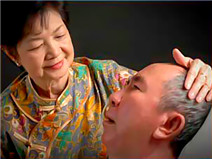高级课程第03单元第05课时

高级课程» 第3 单元» 第5 课时» 活动中心
1 Kid Safety — Basic Story
Children are curious. Sometimes, they are too curious! This can lead to injuries. Many childhood injuries can be
avoided if adults are careful and know how to keep kids safe.
Here are some important things to know about safety:
Always make sure children are safe in a car by having them ride in a car seat. Older children should always
wear a seatbelt when they are a passenger. Be a good example to your child by always wearing your seatbelt.
Install smoke detectors in your home. Put them in the hallway outside of bedrooms and on each floor. Smoke
detectors make a loud noise if smoke is present in the air. Make sure your children know what the sound means.
Talk to them about what to do in case of a fire.
Burns can occur in the kitchen. Whenever you can, cook on the back burners of your stove. Turn the handles in
toward the wall. Always keep hot liquids away from the edge of the stove or table.
Swimming pools are a common site of childhood drownings. However, children can drown in much smaller
bodies of water, such as bathtubs, buckets, basins and toilets. All of these can be a safety hazard. Adults must
always watch carefully when children are playing in or near the water.
Many people keep chemicals, cleaners and medicines in the kitchen and bathroom. Cleaners and medicines
should be stored in a safe, locked place so that children cannot reach them.
Kids love to ride bikes, but they should always wear a helmet. Small children should wear helmets if they ride
on the back of an adult's bicycle. If they fall, a helmet will help protect their brain.
It is also important to make sure babies are safe when they are sleeping. Babies can get their heads stuck in the
slats of a crib. This could cause an injury to the baby's head and neck. To be safe, make sure the slats on a
baby's crib are less than 2 3/8 inches apart.
Safety is important. Knowing how to keep children safe in your home is a great way to show kids how much
you care about them.
2 Kid Safety — Full Story
The curiosity that helps children develop also puts them at risk of injury. The good news is that most childhood
injuries are preventable with proper precautions.
Be safe by doing the following:
From the day you bring your child home from the hospital, he or she must always be secured as a passenger in a
car. Set a good example for your children by buckling up yourself!
Put smoke detectors on every level of your home and in the hallway outside bedrooms. Make sure your kids
know what the sound of a smoke detector means and what they should do in case of a fire.
Whenever possible, cook on rear stove burners and turn pan handles inward on the stove. Be sure to keep hot
foods and liquids out of reach and away from the edge of the table and counter.
Swimming pools are the most common site of childhood drownings, but smaller bodies of water such as
bathtubs, buckets, basins and toilets also present a safety hazard. Provide constant adult supervision for children
playing in or near water.
Research shows that childhood poisonings most often occur in the kitchen and bathroom areas. Store all
medicines, cleaning substances and other poisons well out of children's reach or in a locked cabinet.
A bicycle helmet should be worn every time a child rides a bike, or rides as a passenger on an adult bike.
Crib slats should be no more than 2 3/8 inches apart to prevent the baby's head from getting caught between the
bars. Make sure the crib has no corner posts. Posts can catch clothing and cause strangulation.
3 avoid
keep away from
4 chemical
a substance that can be dangerous if swallowed
5 curious
eager to learn or know something
6 detector
a device that finds something
7 hazard
danger or risk
8 injury
any action that causes pain or damage
9 occur
to take place; happen
10 passenger
a person along for the ride
11 protect
keep safe from danger or harm
12 site
location; a place where something happens






